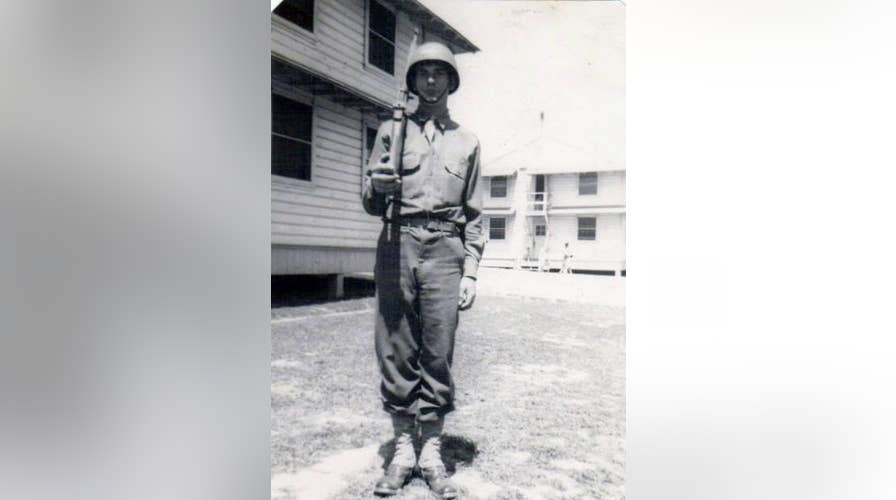World War II veteran recalls fighting in Battle of the Bulge
World War II veteran PFC Robert DeVinney recalls the harsh fighting conditions during one of the most deadly battles in WWII, the Battle of the Bulge
The most perilous periods in any contest — whether in war, politics, or sport — are those moments passed in anticipation of apparent victory. The win is not yet secure, but a sense of inevitable triumph hangs in the air. One’s opponent, however, is still dangerous. The U.S. Army experienced such anticipation with deadly results 75 years ago in the forests of western Europe.
Six months after the Normandy invasion, there was much talk that World War II in Europe was all but over. “Home for Christmas” was a sentiment espoused from top leaders down to frontline troops. But as December snows fell and temperatures plummeted, American soldiers still faced the enemy. Throughout eastern Belgium, Luxembourg and northeastern France, GIs settled in for what they anticipated would be a cold but quiet Christmas.
Meanwhile, undetected and far from being destroyed, the German army had marshaled its strength for one last powerful punch.
On the morning of Dec.16, 1944, Adolf Hitler unleashed 400,000 men and over 1,400 tanks in a massive counterattack along a 65-mile front. Spearheaded by Panzer divisions with Tiger II tanks, its objective was to split Allied forces in half and capture the critical supply port of Antwerp, forcing a peace before the Allies crossed the Rhine into Germany itself.
WWII VETERAN RECOUNTS PEARL HARBOR ATTACK
From out of the wintry gloom this juggernaut crashed through forests and villages and sent American troops reeling in retreat. Allied airpower might have blunted the attack, but planes were momentarily grounded by bad weather. Pockets of resistance stiffened but some units, such as the 101st Airborne Division at Bastogne, were cut off and surrounded. The only saving grace proved to be that snow-covered roads also hampered the German advance.
More from Opinion
In recently liberated towns, there was a sense of dread. American flags hung by locals celebrating freedom only weeks before were quickly taken down as khaki-clad troops loaded into trucks and continued their retreat westward. A war correspondent hastening to pay his hotel bill and escape one Belgium town was assured by the landlady, “That’s all right. You’ll be back in a few days and you can pay me then.” But there was no guarantee and there were tears in her eyes. She, too, had savored the anticipation of victory.
What came to be called the Battle of the Bulge was the bloodiest single battle fought by U.S. troops during World War II. Some 19,000 Americans were killed and more than 46,000 wounded.
Back home in the United States, there had been similar anticipation.
Families preparing for Christmas hoped for the imminent return of loved ones in uniform. My grandmother was one of them. Her only child, a son just turned 19, was coming home on leave after completing basic training. She fervently prayed the fighting would end before he was ordered overseas.
CLICK HERE TO GET THE OPINION NEWSLETTER
But holiday newspapers around the country offered little hope of that and instead told of a growing bulge in the Allied lines. Throughout the Ardennes Forest and across hedgerows and fields, casualties mounted. Bullets, frostbite and bitter cold took their toll and many Americans were taken prisoner. The burden of the fight fell without discrimination among the relatively inexperienced as well the battle-hardened troops of the 28th Infantry Division, ironically “resting” in a supposed quiet area after months in fierce combat.
It took renewed American resolve to prevail and achieve the anticipated victory. After three German lines of attack pushed the bulge deep into American lines, they sputtered to a halt far short of Antwerp. The 2nd Armored Division stopped the Panzer spearhead at Celles and units from Gen. George Patton’s Third Army broke the siege of Bastogne on the day after Christmas. When urged to surrender by encircling German forces, the commander of the 101st Division had replied, “Nuts!” and held on.
CLICK HERE TO GET THE FOX NEWS APP
What came to be called the Battle of the Bulge was the bloodiest single battle fought by U.S. troops during World War II. Some 19,000 Americans were killed and more than 46,000 wounded. The war proved to be far from over that December.
The bulge in the Allied lines was eliminated by February 1945, but the war in Europe went on for another four months. There were many more casualties during campaigns to cross the Rhine into Germany as well as advances in southeastern France and northern Italy. The anticipation of victory had indeed been premature.




















